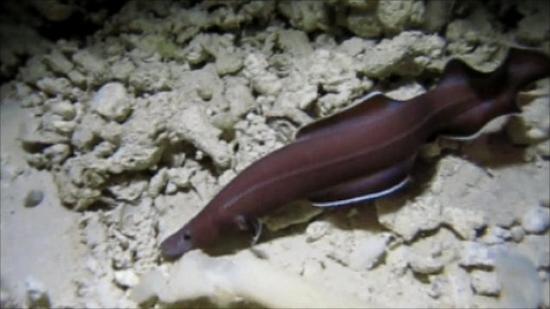一种新鳗鱼生活在太平洋海底的洞穴中,由于具有原始特征,它被称为“活化石”。

太平洋发现的新鳗鱼
研究小组称,鳗鱼的特征表明它具有长达2亿年的独立进化史。
相关的细节报道在皇家学报Royal Society B 上。
这只鳗鱼是18厘米的雌性动物,研究人员潜入水下35米深的洞穴中才发现这只“活化石”。
科学家在研究论文中还提到其它细节。
首先,研究人员讨论了这一动物的亲缘性,遗传分析表明这一动物是“真正”的鳗鱼,即便它是原始种。
在一些方面,它比其它鳗鱼原始的多,甚至比已知的原始鳗鱼还要原始。科学家认为它是没有化石记录的“活化石”。
为了对这一新动物分类,研究人员为它创建一个新的科、种和属,该动物的拉丁名是Protoanguilla palau。
研究小组做出不同鳗鱼的进化树,进而估测P. palau与其它鳗鱼的进化分歧点发生在何时。
研究表明新发现的鳗鱼已独立进化2亿年,它们起源在中生代早期,当时恐龙开始对地球进行统治。(生物探索译 Pobee)
生物探索推荐英文摘要
New Pacific eel is a 'living fossil', scientists say
A new type of eel that inhabits an undersea cave in the Pacific Ocean has been dubbed a "living fossil" because of its primitive features.
It is so distinct, scientists created a new taxonomic family to describe its relationship to other eels.
The US-Palauan-Japanese team say the eel's features suggest it has a long and independent evolutionary history stretching back 200m years.
Details appear in the journal Proceedings of the Royal Society B.
The animal used as the basis for the new study was an 18cm-long female, collected by one of the researchers during a dive at a 35m-deep cave in the Republic of Palau.
But the scientists also mention other examples of the new eel species in their research paper.
At first there was much discussion among the researchers about the animal's affinities. But genetic analysis confirmed that the fish was a "true" eel - albeit a primitive one.
"In some features it is more primitive than recent eels, and in others, even more primitive than the oldest known fossil eels, suggesting that it represents a 'living fossil' without a known fossil record," write the scientists.
In order to classify the new animal, the researchers had to create a new family, genus and species, bestowing on the animal the latin name Protoanguilla palau.
The team - including Masaki Miya from Chiba's Natural History Museum in Japan, Jiro Sakaue from the Southern Marine Laboratory in Palau and G David Johnson from the Smithsonian Institute in Washington DC - drew up a family tree of different eels, showing the relationships between them.
This allowed them to estimate when the ancestors of P. palau split away from other types of eel.
Their results suggest this new family has been evolving independently for the last 200m years, placing their origins in the early Mesozoic era, when dinosaurs were beginning their domination of the planet.
The researchers say the Protoanguilla lineage must have once been more widely distributed, because the undersea ridge where its cave home is located is between 60 and 70 million years old.
生物探索推荐:







